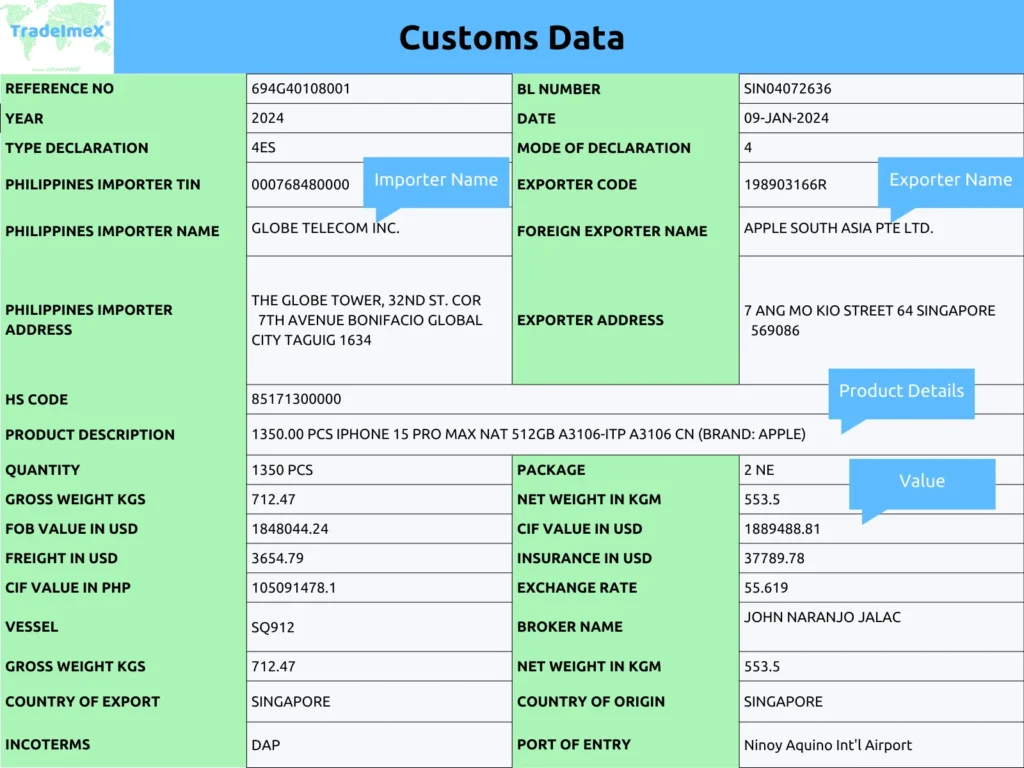In today’s digital and data-driven world, international trade is no longer just about shipping products from point A to point B. It’s about real-time intelligence, smarter decisions, and competitive edge—and that’s where customs data steps in.
Customs data is revolutionizing the way businesses approach global trade. From identifying new markets to analyzing competition and optimizing the supply chain, customs data provides the visibility and clarity that modern businesses need to stay ahead.
In this blog, we explore the importance of customs data, its latest trends in 2025, and how businesses can use it to gain a strategic advantage in the global market.
What is Customs Data?
Customs data refers to the official documentation collected by customs authorities every time a shipment enters or exits a country. It contains detailed information such as:

- Product descriptions & HS Codes
- Quantity & volume of goods
- Value (FOB/CIF) of goods
- Names of importers and exporters (where available)
- Origin and destination countries
- Port details (discharge/loading)
- Shipment mode (Air, Sea, Road, Rail)
This data offers a transparent and detailed view of cross-border trade activities, making it a powerful tool for market analysis and trade planning.
Why Businesses Use Customs Data
Customs data provides actionable trade intelligence that benefits various types of organizations:
- Exporters and Importers can find new buyers/suppliers, evaluate prices, and track trade flows.
- Logistics companies can monitor port activities, routes, and demand patterns.
- Manufacturers can identify sourcing trends and assess raw material availability.
- Analysts and consultants can predict market movements and create country-wise forecasts.
It goes beyond numbers—it delivers real-time business insight.
What Makes Customs Data Valuable?
- Transparency in Trade
Customs data reveals exactly what’s being shipped between countries, along with who is buying and selling. This provides clear visibility into market trends and trading patterns. - Market Opportunity Identification
Businesses can explore high-potential markets by analyzing demand volume, seasonal patterns, and product trends. - Competitive Benchmarking
Track competitor activities—what they’re exporting/importing, from where, in what quantity, and at what price. - Risk Management & Compliance
Ensure trade partners follow correct documentation and avoid red-flagged suppliers or buyers.
Latest Trends in Customs Data (2025)
Let’s take a look at how customs data is evolving and what’s new in 2025:
1. AI-Enhanced Trade Intelligence
Customs data platforms are now powered by AI and machine learning, which enables automated analysis of vast data sets. This helps in:
- Predicting trade trends
- Recommending new buyers/suppliers
- Spotting fraud or trade anomalies
With AI-driven dashboards, businesses can now make faster and more informed decisions.
2. Real-Time Data Accessibility
Increased digitization has allowed for near real-time customs data updates in many countries. Businesses no longer have to wait weeks or months to understand the current market scenario—they get instant access to updated shipment records.
3. Integration with ESG and Regulatory Compliance
Customs data is being used to support environmental and ethical trade. For example, companies can trace the country of origin to verify compliance with:
- Anti-child labor laws
- Environmental regulations
- Carbon border adjustments
This is critical for staying compliant in the EU, US, and other developed markets.
4. Blockchain for Customs Record Security
Blockchain is being explored by customs departments for maintaining tamper-proof, traceable records. This boosts trust, enhances security, and reduces document fraud across international supply chains.
Customs Data Coverage: Countries & Scope
In 2025, customs data is available for more than 80+ countries across continents. The data includes import-export records from regions like:
- Asia – India, Vietnam, Indonesia, Philippines, China
- America – USA, Mexico, Brazil, Argentina, Chile
- Europe – Russia, Ukraine, Turkey
- Africa – South Africa, Kenya, Egypt
- Middle East – UAE, Saudi Arabia, Iran
Each country offers varying levels of detail, but many include shipment-level transaction data, complete with HS codes and trade partner names.
How Businesses Use Customs Data in 2025
Here are some real-world applications of customs data:
🔍 Discover New Buyers and Markets
By analyzing historical customs data, exporters can identify countries where demand is growing for their product category and see who the top importers are.
📊 Monitor Competitor Activities
Check who your competitors are exporting to, what price they’re offering, and how frequently they’re shipping. This data helps in strategy building and pricing.
📦 Validate Trade Partners
Before finalizing a deal, verify if a potential buyer or supplier has a genuine trade history by checking their shipment records.
📈 Track Trade Growth and Trends
Compare year-over-year growth in trade volumes, detect seasonality, and prepare inventory based on demand forecasts derived from customs patterns.
Key Features to Look for in a Customs Data Platform
When choosing a customs data solution, ensure it includes:
- Easy access to global data from 80+ countries
- HS code-wise filtering and advanced search tools
- Monthly or daily data updates
- Visual dashboards and downloadable reports
- Trade analysis support with graphs and historical insights
- Option to download data in Excel or PDF formats
These features simplify analysis and enable faster decision-making.
The Future of Customs Data
The future of customs data is more intelligent, integrated, and impactful. With innovations in AI, IoT, and blockchain, customs intelligence will not only support trade—it will shape it.
Here’s what’s ahead:
- Smarter integration with supply chain visibility tools
- Instant alerts on market shifts or trade anomalies
- Seamless link to export-import regulations and compliance tools
- Support for digital trade corridors and smart customs clearance systems
As governments push for trade digitization, the role of customs data will only grow stronger.
Final Words
In 2025, customs data is the currency of global trade intelligence. Whether you’re an importer, exporter, manufacturer, consultant, or freight forwarder—having access to clean, structured, and timely customs data gives you a clear edge in today’s competitive landscape.Customs Data
It’s not just about what’s being traded—but who, where, when, and how.
If you want to understand your market better, discover new leads, monitor competitors, and make smart trade decisions, customs data is the answer.
Ready to explore the power of customs data?
Access global import-export insights and boost your business with detailed shipment-level intelligence.
Also Read New blog about: Malaysia Exports


